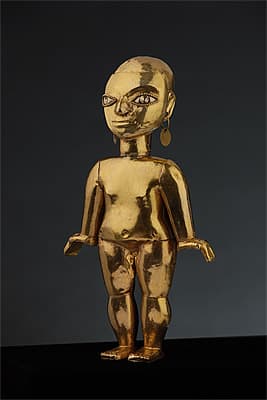VICÚS culture North coast 100 BC – 400 AD
FRÍAS style 200 – 600 AD
Female figure, known as The Venus of Frías 200-600 AD gold and platinum , soldered construction15.3 (h) x 8.7 (w) cm Ministerio de Cultura del Perú: Sala de Oro del Museo Municipal Vicús, Piura Photograph: Daniel Giannoni
This unique sculpture was found near Piura in the Frías Valley. Like other objects found in the same area, the figure displays stylistic links to the Vicús and also the Moche, as well as Ecuadorian and Colombian cultures. She is completely hollow, constructed from sheet gold with soldered seams at the joints. Unusually, her eyes are inlaid platinum. Although naked, the figure may have been dressed in cloth garments before being placed in the tomb, a common practice in the Andes.
This unique sculpture was found near Piura in the Frías Valley. Like other objects found in the same area, the figure displays stylistic links to the Vicús and also the Moche, as well as Ecuadorian and Colombian cultures. She is completely hollow, constructed from sheet gold with soldered seams at the joints. Unusually, her eyes are inlaid platinum. Although naked, the figure may have been dressed in cloth garments before being placed in the tomb, a common practice in the Andes.
This unique sculpture was found near Piura in the Frías Valley. Like other objects found in the same area, the figure displays stylistic links to the Vicús and also the Moche, as well as Ecuadorian and Colombian cultures. She is completely hollow, constructed from sheet gold with soldered seams at the joints. Unusually, her eyes are inlaid platinum. Although naked, the figure may have been dressed in cloth garments before being placed in the tomb, a common practice in the Andes.


